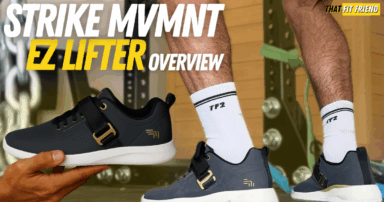If you’ve ever been to a proper strength sports gym, you’ve likely noticed that there are many different barbells that you can train with. Every barbell has its unique list of characteristics, making it great for certain types of lifting.
For beginners, this can be confusing and intimidating at times. For example, when should you use a power bar, and when should you use a weightlifting bar? Are they interchangeable, and what makes each barbell good?
There are a handful of characteristics that differentiate barbells from one another. Things like collar rotation, rigidity and tensile strength, and knurling are common differences between barbells.
Table of Contents+
Barbell Comparison Takeaways
What Is a Power Bar?
A power bar is a barbell designed to be used primarily for powerlifting and heavier strength training. This is the type of barbell that most powerlifting federations will use for competition.
What Makes a Power Bar a Power Bar?
- Aggressive Knurling: Most power bars will have more aggressive knurling which is great for supporting grip when the barbell is on the back for squats and for giving you additional grip for deadlifts.
- Center Knurling: Power bars will utilize center knurling to promote more bite on shirts when squatting.
- 29mm Diameter: Most power bars will have a diameter of 29mm and this is a feature that is designed to make these bars less whippy but also consistent for competition.
- Moderate Tensile Strength: Power bars are notorious for not having a ton of whip. When training, these bars feel very stiff and rigid and have moderate degrees of tensile strength with shorter lengths as they’re not designed to whip and bend.
- Shorter Length: Power bars also typically have shorter lengths compared to barbells like squat bars and deadlift bars.
When to Use a Power Bar
- Powerlifting: If you’re planning to compete in powerlifting or do compete in powerlifting then you’ll want to explore using a power bar depending on the federation that you compete in.
- General Strength Training: For recreational lifting and general strength work, a power bar can work well and it’s somewhat of a Swiss army knife regarding its utility in this context.
- Grippiness for Squats: If you’re a low-bar squatter or want more bar security in general when the barbell is on your back, then a power bar can be a great pick due to its aggressive knurling.
When to NOT Use a Power Bar
- Weightlifting: A power bar’s collars won’t have the best rotation and the center knurling can wreak havoc on your neck when catching cleans.
- CrossFit: Similar to weightlifting, a power bar will lack the versatility needed for most CrossFit and functional fitness workouts.
What Is a Weightlifting Bar?
Generally speaking, a weightlifting bar will be the most costly of the barbells that you can buy. For example, a good weightlifting bar with bearings can easily cost around $1,000 USD. Note, when I say “weightlifting bar” I’m referencing the bar that is used in the sport of weightlifting.
What Makes a Weightlifting Bar a Weightlifting Bar?
- Collar Bearings and Bushings: A weightlifting bar’s collars are designed to spin and rotate and most bars will use bearings and bushings. Higher-quality bars will typically use bearings.
- No Or Smooth Center Knurling: Weightlifting bars will either not have center knurling or they’ll utilize smooth knurling to prevent the neck from getting overly scratched up when catching cleans.
- Moderate Knurling: A good weightlifting bar will have a moderate level of knurling aggressiveness. It will typically be more aggressive than general training bars but less than a power or deadlift bar.
- More Whip: Weightlifting bars usually have higher amounts of tensile strength and have more whip to them compared to something like a power bar.
- 28mm Diameter: Pretty much every weightlifting bar will have a 28mm diameter and barbells used in competition will have this diameter.
When to Use a Weightlifting Bar
- Weightlifting: If you’re planning to compete or already compete in the sport of weightlifting then you’ll want to use a weightlifting bar. This barbell will be specific to what you’ll use in competition.
- CrossFit: Some gyms will utilize cheaper weightlifting bars for CrossFit WODs, but this is NOT an all-of-the-time occurrence. If your box has weightlifting bars and general training bars, always ask which they prefer you use.
- Weightlifting Accessories: If you’re training snatch and clean & jerk variations and accessories then it’s a good idea to use a weightlifting bar as you’ll want its specificity.
When to NOT Use a Weightlifting Bar
- General Strength Work: For general strength work where you’re hitting exercises like bench press, you’ll want to use a power or general training bar. The rotation of a weightlifting bar’s collars can change the mechanics of lifts.
- Low-Bar Squatting: If you’re low-bar squatting, you’ll want to use a barbell that has a better knurling layout to give you more bite, security, and grip. Weightlifting bars can feel “slippery” when using them for low-bar squats.
- Rack Pulls: Do NOT use weightlifting bars for exercises like rack pulls. To be honest, you should limit a weightlifting bar’s use to only weightlifting if you want the knurling and barbell to last regarding not getting warped.
What Is a Deadlift Bar?
Lifters from all walks of life tend to have love-hate relationships with deadlift bars. Some lifters love them and refuse to deadlift with anything different while others (like me) don’t necessarily love their performance.
What Makes a Deadlift Bar a Deadlift Bar?
- Aggressive Knurling: Deadlift bars will utilize aggressive knurling to give you the most grip possible when pulling heavy weight. If you’ve ever used a fresh deadlift bar then your hands are probably radiating from reading this.
- More Whip: Deadlift bars are designed to flex and whip a lot. These will be the whippiest bars on the market meaning they have the most flex and bend to them when lifting.
- Longer Length: Deadlift bar lengths can vary, but in general, deadlift bars will be longer than your traditional power and training barbells. This longer length feeds into their extra whippiness.
- Thinner Diameter: Deadlift bar diameters can also vary a bit but in general you’ll see deadlift bars use a 27mm diameter and this is designed to give you more surface areas when gripping deadlifts.
- Lower Tensile Strength: Typically, you’ll see lower amounts of tensile strength used in deadlift bars. This is another feature that feeds into this barbell’s whip.
When to Use a Deadlift Bar
- Deadlifting: Keep a deadlift bar’s use solely for deadlifting and you’ll not only get more out of your performance, but you’ll make your deadlift bar last longer.
When to NOT Use a Deadlift Bar
- For Anything That’s Not Deadlifting: Just don’t. A deadlift bar’s whip can cause mechanical changes when using it for other lifts. On top of this, you’ll break down a deadlift bar faster by using it for other lifts. Can it be used for accessories like RDLs following deadlifts? Sure, but even then, I typically opt for a bar with less whip in this context.
What Is a Squat Bar?
A squat bar will be the most specific barbell that’s featured in this beginner’s barbell guide. This barbell will typically only be found in gyms that have a focus on powerlifting as that’s one of the only occasions when you’ll really use this barbell.
What Makes a Squat Bar a Squat Bar?
- Thicker Diameter: Most squat bars will have diameters that are around 32mm thick. Since this bar is primarily used for squats, the diameter helps provide additional stiffness when using this bar.
- No Whip: With a thicker diameter and fairly high tensile strength, squat bars are designed to have virtually no whip when using them for heavy squat sessions.
- Full Center Knurling: The increased placement of knurling on this barbell can be great for low-bar squats as it will provide additional bite on the back.
- Longer Length: Most squat bars will be built longer than traditional bars and this can be useful for larger lifters with limited shoulder mobility.
- Aggressive Knurling: The knurling on squat bars will typically be more aggressive in nature to promote security when the barbell is on the back.
When to Use a Squat Bar
- Squatting: If you’re a powerlifter that competes in a federation that uses squat bars, a strongman athlete that needs the additional length, or a lifter with limited shoulder mobility, then a squat bar makes sense for your training.
When to NOT Use a Squat Bar
- Anything Outside of Squatting: You’ll want to avoid using a squat bar for exercises outside of squatting. Its diameter will change its feel compared to normal barbells.
Frequently Asked Questions (FAQ)
Q:Are barbells always 45 lbs?
Q:Are barbells 44 or 45 lbs?
Q:How much do power bars weigh?
Takeaway Thoughts
There are a lot of different barbells on the marker that you can use for training. As you get more specific with your lifting goals, your equipment usage will likely follow suit.
For strength sports, barbells can be a really big deal as most federations in every strength sport will use a specific type of barbell for competition.
If you have additional questions about the barbells featured here, drop a comment below or reach out to me personally via Instagram (@jake_boly or @that_fit_friend).

















Add a Comment